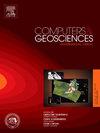Numerical simulations of time-domain seismic wave propagation for a point source in 2-D onshore and offshore geological models
IF 4.2
2区 地球科学
Q1 COMPUTER SCIENCE, INTERDISCIPLINARY APPLICATIONS
引用次数: 0
Abstract
This research demonstrates an innovative numerical technique to simulate seismic wave propagation of a practical point source in complex 2-D geological models, which encompass a free surface topography, an undulating seafloor, and acoustic, elastic isotropic, viscoacoustic and viscoelastic anisotropic rocks. This technique is particularly beneficial in scenarios where 3-D wave modeling is resource-intensive and may efficiently offer the 3-D wavefields from arbitrary 2-D geological models often encountered in practice. Based on the point-source viscoelastic wave equations in a 2-D heterogeneous tilted transversely isotropic (TTI) medium, representative of subsurface igneous and sedimentary rocks, we tailor the wave equations valid for different rocks and the boundary conditions of the free-surface topography and seafloor and adapt the conventional memory variable method and the newly developed Taylor-series recursive convolution method to solve such point-source comprehensive wave equations. To overcome the inherent computational intensity of the methods, we convert the complex domain into a real domain and implement a fully parallelized computing strategy to ensure that the runtime of the numerical simulation remains on par with that of common 2-D wave modeling. Our experimental validations confirm the accuracy of the Taylor-series recursive method to offer the 3-D wavefields in an arbitrary heterogeneous 2-D geological model having a free-surface topography or an undulating seafloor. Moreover, our applications of this technique to two benchmark practical 2-D geological models demonstrate its capability to replicate 3-D wavefields in arbitrary viscoelastic anisotropic media, and greatly help in interpreting offshore and onshore seismic data and generating an accurate image of the subsurface.
陆上和海上二维地质模型中点源时域地震波传播的数值模拟
本研究展示了一种创新的数值技术,在复杂的二维地质模型中模拟实际点源的地震波传播,这些模型包括自由表面地形,起伏海底,声学,弹性各向同性,粘声和粘弹性各向异性岩石。该技术在三维波建模需要大量资源的情况下特别有用,可以有效地从实际中经常遇到的任意二维地质模型中提供三维波场。基于以地下火成岩和沉积岩为代表的二维非均质倾斜横向各向同性(TTI)介质中的点源粘弹性波动方程,根据不同岩石、自由地表地形和海底的边界条件,定制了适用于不同岩石的波动方程,并采用传统的记忆变量法和新发展的泰勒级数递推卷积法求解这类点源综合波动方程。为了克服这些方法固有的计算强度,我们将复域转换为实域,并实现了完全并行化的计算策略,以确保数值模拟的运行时间与普通二维波建模的运行时间相当。我们的实验验证证实了泰勒系列递推方法在具有自由表面地形或起伏海底的任意非均匀二维地质模型中提供三维波场的准确性。此外,我们将该技术应用于两个基准的实际二维地质模型,证明了它能够在任意粘弹性各向异性介质中复制三维波场,并极大地帮助解释海上和陆上地震数据,并生成准确的地下图像。
本文章由计算机程序翻译,如有差异,请以英文原文为准。
求助全文
约1分钟内获得全文
求助全文
来源期刊

Computers & Geosciences
地学-地球科学综合
CiteScore
9.30
自引率
6.80%
发文量
164
审稿时长
3.4 months
期刊介绍:
Computers & Geosciences publishes high impact, original research at the interface between Computer Sciences and Geosciences. Publications should apply modern computer science paradigms, whether computational or informatics-based, to address problems in the geosciences.
 求助内容:
求助内容: 应助结果提醒方式:
应助结果提醒方式:


